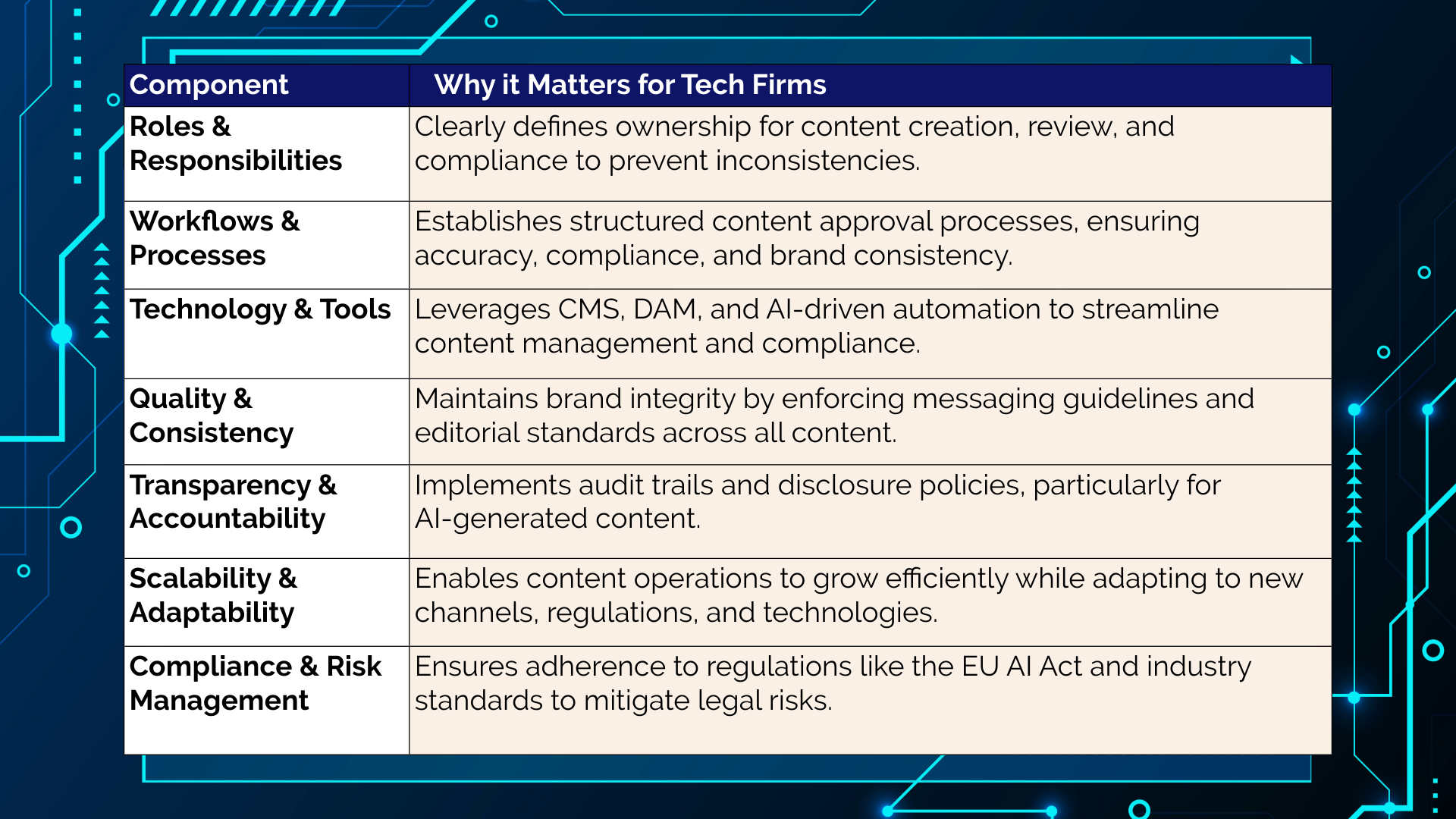|
Summary:
- As AI-generated content proliferates and regulatory scrutiny increases, tech firms must adopt structured governance models to ensure accuracy, compliance, and brand consistency.
- Clear policies, roles, workflows, and technology solutions help manage content at scale, ensuring regulatory alignment and streamlined marketing operations.
- By maintaining transparency, ethical standards, and compliance, tech firms can safeguard their brand, strengthen trust, and drive long-term business growth.
Tech firms understand that data and AI governance are non-negotiables in an increasingly regulated technology landscape. Governance ensures that data is trustworthy, secure, and aligned with business objectives.
In 2025, this same principle and approach must be applied to content. This area often goes overlooked as organizations refine their approach to data and AI governance.
Just as organizations can’t afford to operate without a structured approach to managing data and AI, they also can’t afford unchecked, inconsistent, or non-compliant content. The saturation of AI-generated content, increasing regulatory scrutiny, and changing customer expectations demand a governance model that ensures content is accurate, transparent, and aligned with both business strategy and compliance standards. Without a robust content governance model, even leading tech firms risks misinformation and diminished brand credibility.
This blog explores why content governance is now a critical component of a strong governance model, and how tech firms can implement governance strategies to protect their brand, improve marketing efficiency, and stay ahead in an increasingly complex regulatory and technology environment.
What Is Content Governance?

Content governance is the framework that defines how an organization creates, manages, and maintains content to align with business objectives, regulatory standards, and audience expectations. It involves a structured approach to managing content across its entire lifecycle, from ideation and creation to distribution and retirement. It ensures that every blog, product update, and customer-facing asset meets the standards of accuracy, legality, and brand consistency.
This practice helps support consistency, efficiency, and compliance in an increasingly complex digital environment. For tech firms, where content can range from technical documentation and marketing campaigns to GenAI-produced blogs and customer success stories, having a clear content governance structure is critical to scaling content efforts while minimizing risks and maximizing impact.
Content governance supports:
- Regulatory compliance: Adhering to global regulations like the General Data Protection Regulation (GDPR), California Consumer Privacy Act (CCPA), or the Artificial Intelligence Act of the European Union (EU AI Act).
- Risk mitigation: Proactively address content risks, from misinformation to data breaches.
- Accuracy: Maintaining the reliability and integrity of highly technical or regulatory-dependent information.
- Efficiency: Streamlining processes across diverse global teams managing a large global content ecosystem.
- Scalability: Managing global content efficiently, even in diverse regulatory environments.
- Trust: Building credibility with audiences and B2B decision-makers through consistent, transparent communication.
Tech firms must right-size content governance
Content governance isn’t defined by a universal standard; every tech firm must adapt and shape their own policies according to the specific needs of their organization. While some firms might focus heavily on regulatory compliance due to operating in highly regulated markets, others may prioritize brand consistency or the development of dynamic, real-time content for rapidly evolving markets.
Effective content governance requires a tailored approach that supports a firm’s unique content supply chain, including the volume of content produced, the diversity of audiences served, and the complexity of their product offerings. Customizing governance frameworks, including policies, roles, workflows, and technology, helps content to remain impact while aligned with business goals.
A foundational content governance strategy includes:
Policies and Guidelines:
Content governance starts with established rules for content creation, tone, formatting, and compliance to facilitate consistency across platforms and teams. Brand guidelines, for example, might specify the tone for communicating product updates or the specific legal disclaimers required in marketing materials.
Roles and Responsibilities:
Content governance assigns clear ownership for every stage of content production. Everyone in the content lifecycle, including content creators, editors, project managers, and compliance officers, understands their role and ensures there’s no gaps in quality or legality.
Workflows and Processes:
Structured workflows govern how content moves from ideation to publication. This extends to approval checkpoints for legal compliance, brand alignment, and accuracy, particularly critical in tech industries dealing with fast-evolving regulations.
Tools and Technology:
Effective content governance leverages content management systems (CMS), digital asset management (DAM) systems, and AI tools to automate tasks like metadata tagging, compliance checks, and analytics.
Monitoring and Auditing:
Content governance doesn’t stop at publication. It involves regular audits to ensure content remains up-to-date, relevant, and adheres to changing regulations and standards.
The State of Tech Content in 2025
The landscape of tech content is transforming at an unprecedented rate. Several emerging key trends are reshaping how content is created, distributed, consumed, and regulated, emphasizing the need for robust content governance.
- AI-generated content alters how tech firms produce materials like blogs, user manuals, and chatbots; this potentially leads to challenges in ensuring content adheres to ethical standards, maintains transparency with audiences, and aligns with brand voice.
- Customer expectations for complete transparency and personalized experiences impact brand interactions; nearly 50% of consumers indicated they would switch brands if an organization was unclear about its data practices, emphasizing the need for consistent, accurate disclosures and messaging across all customer touchpoints.
- New and immersive content channels, including augmented reality (AR), virtual reality (VR), and internet of things (IoT) devices, pose new complexities in managing content across diverse platforms and enforcing content quality control.
- B2B buying cycles are growing more complex, with decision-makers consuming content from whitepapers, webinars, and AI-driven recommendations; governance enables messaging to remain brand-aligned, accurate, and consistent across all channels and touchpoints.
- The EU AI Act establishes stricter guidelines for AI-generated content, transparency, and accountability; tech firms must ensure AI-generated content - including marketing assets, customer support interactions, automated chat interactions, and product documentation - meet disclosure requirements and maintain human oversight.
Best Practices for Content Governance in 2025

Despite the role governance plays in driving marketing strategy consistently throughout brands, categories, and markets, just 12% of marketing-growth leaders have implemented this approach.
To build an effective content governance model that aligns marketing, business priorities, and shifting regulatory conditions, tech firms must:
- Define clear strategic objectives that align with marketing goals, like driving demand, increasing engagement, and supporting sales enablement, while also ensuring compliance with evolving regulations like the EU AI Act.
- Establish roles and ownership within the content lifecycle. Marketing teams must enforce messaging consistency and brand alignment, while content strategists should oversee editorial standards and content frameworks. Compliance and legal teams should play a role in reviewing content for regulatory risks, and sales teams should provide feedback on content effectiveness to ensure alignment with buyer needs.
- Standardize content workflows via approval processes that are built into content production, particularly for assets such as AI-generated content. Content frameworks help maintain consistency, aligning all published materials with brand voice and positioning. Incorporate checkpoints for legal, brand, and compliance reviews before publication.
- Leverage CMS and DAM platforms to help marketing teams organize, access, and control content. AI-powered tools can automate content tagging, sentiment analysis, and compliance checks, reducing the manual effort needed to maintain governance standards. Marketing automation platforms can further enforce governance at scale, ensuring high-volume content production remains compliant and on-brand.
- Implement protocols for GenAI-produced and regulated content, including labeling content to comply with regulations like the EU AI Act; ensuring accuracy across technical information, such as product documentation and compliance statements; and establishing rules to avoid deceptive practices in marketing and user-facing content.
- Establish content audit trails to track revisions and regulatory adherence, particularly as AI-generated content becomes more prevalent. This should extend to disclosure policies for AI-assisted content to maintain transparency with customers and stakeholders.
- Set KPIs to track content effectiveness, compliance, and engagement, then leverage this data to refine your content governance strategy. Regular audits can help identify process gaps, while feedback loops from marketing, sales, and compliance teams ensures governance remains agile and relevant.
Don’t Disregard the Value of Content Governance
As AI-generated content becomes increasingly prolific in 2025, maintaining transparency, ethical standards, and compliance will be paramount. Effective content governance ensures that organizations can confidently manage the lifecycle of their content, from creation to publication, while safeguarding against risks such as bias and inaccuracies.
Integrating governance into every stage of the content marketing lifecycle can help tech firms ensure their content strengthens brand credibility, fosters long-term audience trust, and drives business growth.
|







